

| Gull records at Eakring and Kersall 1998-2007 | ||
| Gulls are not to every birdwatchers taste and my own interest in gulls has only really increased during the last couple of years. This page looks at the area's gull records over the past ten years and highlights the status of the gulls recorded here and the most notable counts per species. | ||
| ..... | ||
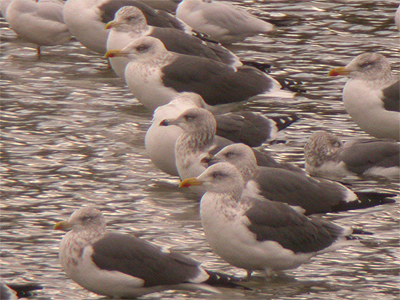 |
Most of the gull passage
during the Autumn/Winter is generally to the south-west
in the morning, with a return north-easterly movement of
Lesser Black-backed Gulls usually only noted in the
evening during the late Summer months. Movements during
the Winter afternoons and evenings seems less
directional. Within the past ten years, there have been some surprising counts made, especially bearing in mind that there is no well determined roost/feeding site flight over the area. The nearest tip to Eakring is the one at Bilsthorpe. However, Bilsthorpe tip is not comparable to that of Dorket Head near Nottingham or the (now closed) Burntstump and Huthwaite landfill sites. Although some tipping still goes on at Bilsthorpe, it does'nt seem large enough to attract numbers of gulls. Most of the birds that it does pull in, may actually originate from the Hoveringham roost in the Trent valley as there seem more birds than I've had fly over the area on any one morning. |
|
| ..... | ||
| During the
Winter months, small numbers of Herring, Great
Black-backed and Lesser Black-backed Gulls are seen in
(or over) the Eakring area and there are even fewer
occasions between November and February when these gulls
accumulate in fields here. Most of the largest counts at
this time, have come when the weather turns much colder
and genuine influxes inland occur. Most larger gulls seen
from early November through to early December move
south-west and these movements can continue throughout
the day on occasions. As a rule, a three-figure Herring
Gull count here is very rare and over 100 Great
Black-backed Gulls have yet to be seen during any one
day. Lesser Black-backed Gull is probably the most commonly species seen here, with large numbers building up during August and September, when most of the cereal crops are being harvested. Careful searching through these has revealed numerous Yellow-legged Gulls and a single Caspian Gull over the years. Flocks are regularly prone to disturbance from agricultural machinery, which makes the process of identification and counting of large numbers difficult to say the least. Details and notable counts of the gulls recorded at Eakring and Kersall |
||
| Little
Gull Larus minutus |
|||||
One record of a flock of nine birds moving north-east over Eakring Flash on April 20th 2003, coming during a period of anticyclonic weather, overcast with north-easterly winds. |
|||||
| Common
Gull Larus canus |
|||||
Common Gull numbers generally peak here during November, but there are occasionally good counts early in the year. Groups regularly hunt over winter cereal fields, particularly if the weather has been wet. Common Gull counts of over 30 are significant at Eakring. There have been just two records from late April-early July which are a 2cy on June 3rd 2000 and an adult on April 23rd 2005. The most notable influx was of 46 on the extremely early date of July 23rd 2000, coinciding with a period of overcast weather, north-easterly winds and a large influx of Black-headed Gulls. The highest count is of 122 on December 8th 2007, including one group alone of 67 at Eakring Flash. Other notable counts include:- 36 on January 23rd and 31 on Nov 7th 2000; An influx during the third week of January with counts of 50+ on both 21st and 23rd, with 83 on 22nd and 74 on 28th and 76 present on Feb 11th 2003; A very high count of 97 at Leyfields, with many birds coming in from the south on March 21st 2006; Good site counts of 49 at Leyfields/Eakring Flash on November 16th and 62 on November 17th, before 75 at Eakring Flash and Church Hill on November 25th 2007. |
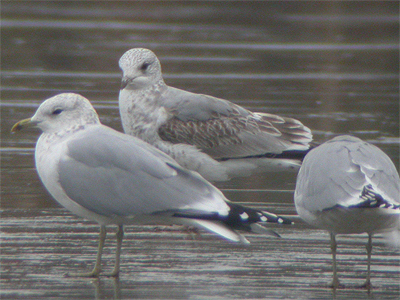 |
||||
| Black-headed
Gull Larus ridibundus |
|||||
Although an extremely common species here, large numbers are very rare and I could find reference to just four three-figure counts since 1998. Many of the area's records typically involve small groups or less. A north or north-easterly passage is often noted during late February through to April, with odd birds appearing during May and occasionally June, but it is often during August that records increase in regularity. Many Autumn records involve birds moving west or south-west. The only large counts include:- 388 arriving from the east on July 23rd 2000; 500 Jan 1st 2001; 61 Mar 5th 2005; 119 west Feb 19th 2007. |
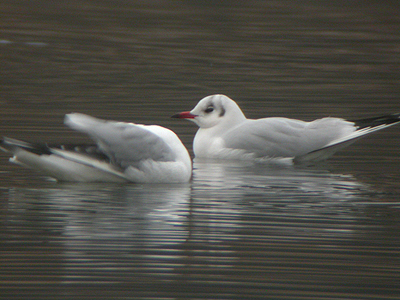 |
||||
| Lesser
Black-backed Gull Larus
fuscus graellsii |
|||||
The commonest of the larger gulls. Lesser Black-backed Gull numbers reach a pronounced peak between early July and late October. The ratio between the number of immature (hence non-breeding birds) and adults decreases, the nearer it is to October. Away from these periods, numbers are considerably smaller and there are more adults than immatures. A high northerly movement is noted during the Spring (March-May) but only small numbers have so far been recorded during this time. A record count of 828 Lesser Black-backed Gulls was made in fields at Eakring Field Farm on September 8th 2007. On October 19th 2002 a colour-ringed Lesser Black-backed Gull was present at Tug Bridge Farm. Research showed that it had been rung at South Walney NR in Cumbria in either 1998 or 1999. |
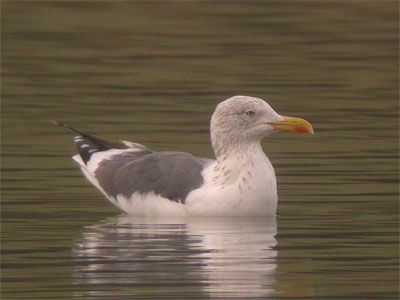 |
||||
| ..... | |||||
| Notable counts during the last ten years include the following:- 224 July 25th, followed by 420 on August 31st 2000; A large count of 750+ was made on August 18th 2002; 300-400 on August 20th 2003; Two good counts of 250+ on August 12th and 300+ on September 9th 2006; 564 on August 5th preceded the area's largest ever count. 350 were noted on both October 4th and 27th 2007. | |||||
| Herring
Gull Larus argentatus |
|||||
There are two distinct arrival periods for Herring Gulls in the area. UK breeders (argenteus) are usually first noted from mid-late September, but occasionally earlier, although records are uncommon enough to be considered notable. Usually an indicator of the arrival of much colder weather in northern areas are Herring Gulls of Scandinavian origin, i.e. the nominate race argentatus, which start to move through from mid-November. This often coincides with an increase in the number of Great Black-backed Gulls moving through. Herring Gulls are rare here in large numbers, but it occurs daily throughout the Winter. Late-April and May records are unusual. There are just four counts from the area between 1998 and 2007 that actually reach three figures. Notable records are:- 126 on November 9th 2000; 136 moving south-west January 1st, 80 at Leyfields on December 6th 2001; 68 west on January 6th, 95 in fields at Eakring Flash on November 21st 2003; 104 on January 22nd 2005; 86 on January 29th 2006 and a record 166 south-west on November 25th 2007. |
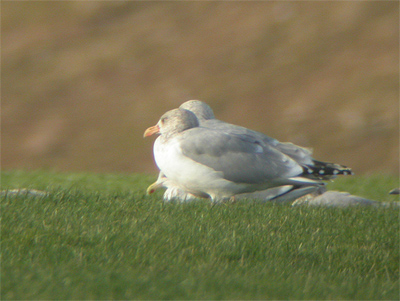 |
||||
|
|||||
| Yellow-legged
Gull Larus michahellis |
|||||
| Yellow-legged Gulls are scarce, but increasingly regular visitors to the area. The first birds appear from July, with records showing a clear peak during the month of September. The only Winter records are of single 1st Winter birds in January and February 2001. 2007 represented a particularly good year for Yellow-legged Gulls here, but there seemed no general increase in numbers across Nottinghamshire at the time. Opposingly, there were no records for 2004 and just one record in 2005. A count of six on September 8th 2007, is the highest Yellow-legged Gull count to date. | |||||
| ..... | |||||
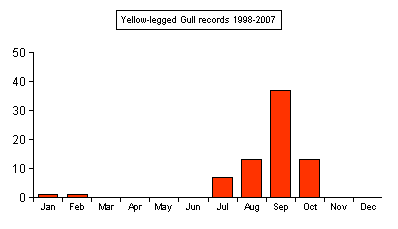 |
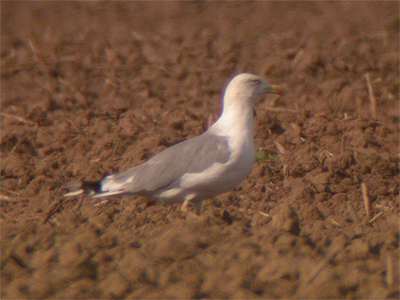 |
||||
| ..... | |||||
| The full list of Yellow-legged Gull records,
between 1998 and 2007 is shown below. The list is quite
extensive, especially after such a good year like 2007. An adult August 15th, An adult September 3rd, 1998; A 2nd summer south-west July 24th, An adult Eakring Flash July 30th, An adult north-east August 7th, two adults Tug-Bridge Farm, September 5th, Three adults, Eakring Field Farm September 13th, Four adults, Eakring Field Farm September 19th 1999; An adult moving north-east July 16th, An adult moving north-east July 25th, A 3rd Summer moving south-west on September 23rd 2000; A 1st Winter in the Eakring Flash area on January 20th, A 1st Winter at Eakring Flash, February 9th, An adult and a 3rd Winter near Parkhill Plantation September 8-11th, An adult moving south-west October 7th, An adult in fields at Red Hill October 19th 2001; An adult at Church Hill September 4th, An adult September 12-13th, An adult September 18-21st, Two adults at Tug Bridge Farm October 11th, An adult at Eakring Flash October 16th 2002; An adult near Eakring Meadows September 11th, Two adults October 11th, An adult at Eakring Flash October 13-16th 2003; Two (a 2nd Summer and 3rd Summer) in fields near Eakring Flash July 24th 2005; A 3rd Summer near Eakring Flash July 29th, An adult and a 3rd Summer in fields north of Leyfields August 12th, An adult at Eakring Field Farm August 19th, An adult at Park Farm/Eakring Field Farm September 5th 2006; One in fields near Leyfields and Church Hill August 4-5th, Two in fields at Church Hill August 9th, A 2cy near Eakring Flash, August 18th, Three adults at Church Hill August 23rd, A 1cy in fields between Eakring and Kneesall August 25th, Five in the area, including a 1cy, 3cy and three adults at Church Hill and near Eakring Field Farm September 3rd, Three at Church Hill including two adults and a 3cy bird September 5th, Six, including two adult females, two adult males, a 2cy male and a 1cy male at Eakring Field Farm September 8th, Five (two adult females, one adult male, a 1cy female and a 1cy male) at Eakring Field Farm September 9th, An adult near Eakring Field Farm September 17th, An adult female at Church Hill September 26th, A 3cy bird near Leyfields October 4th, An adult at Park Farm October 6th, Two adults at Church Hill October 13th, An adult and a 1cy at Church Hill October 14th 2007. |
|||||
| Caspian
Gull Larus
cachinnans |
|||||
| The only record to date, was of an adult in fields north of Red Hill, amongst c400 Lesser Black-backed Gulls on August 20th 2003. | |||||
| Iceland
Gull Larus
glaucoides |
|||||
| There are two records of Iceland Gull, which probably related to the same bird. An adult flew south-west over Leyfields on December 31st 2000, then again south-west over Eakring Flash on January 1st 2001. | |||||
| Great
Black-backed Gull Larus marinus |
|||||
Great Black-backed Gulls are rare in numbers at Eakring. Since 1998, there have been just three counts including 49 on November 9th 2000, 77 moving south-west on January 10th 2004 and 50 moving south-west on November 25th 2007. Influxes seem to coincide with the arrival of argentatus Herring Gulls. There is just one Summer record and the first birds rarely appear before the end of September. An increase in sightings usually comes during early November of most years, but Great Black-backed Gulls are not recorded on a daily basis, even during the depths of Winter. |
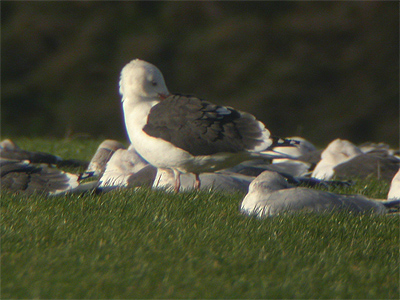 |
||||
| Kittiwake Rissa tridactyla |
|||||
There are three records of Kittiwake. One moved south-east over Red Hill on October 3rd 1998 and remained the area's only record until two in 2007. Two 1st Winter birds moved west on September 27th, followed by an adult moving north-east over Eakring Flash on November 10th 2007. |
|||||